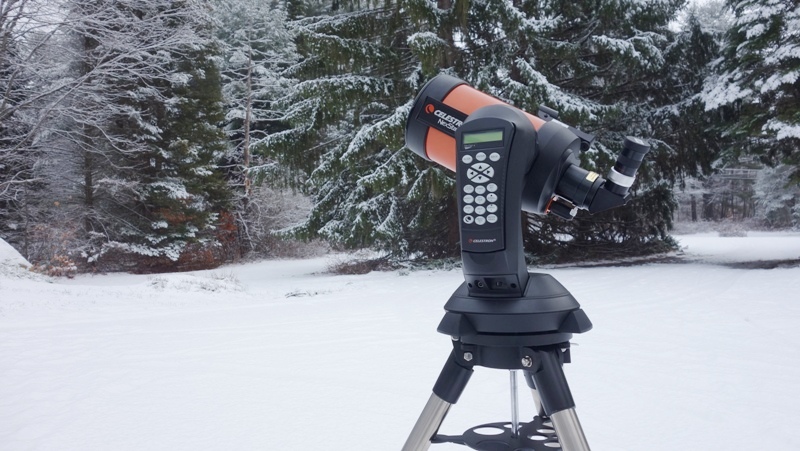
Updated 12/12/16, 2/15/17
1) Celestron NexStar 5se 12/12/16
2) Skywatcher 10" Collapsible Dobsonian 2/15/17
(5" f/10 SCT on NexStar Goto mount, red dot finder, diagonal, 25 mm eyepiece, $599 - $699)
Celestron's NexStar series has long been a popular choice for observers looking for a mid-priced Goto telescope system. The package is compact, the optics are good, and for the most part the performance of the Goto system is decent. You get a lot for your money. The 5, in particular, is attractive because of its extreme portability. It will fit an almost any car with room to spare, and the entire scope weighs less than 18 lbs.
You can often tell an advanced hobbyist from the beginner or the intermediate. Beginners usually refer to their rigs as one piece. It's simply "my telescope." As we get more involved, we start referring to our scopes in two parts - the optical tube assembly and the mount. We start getting more picky and start switching parts around. Luckily, the NexStar series can grow with you. You can separate the OTA from the mount and switch them out for other pieces to see how they work. I don't know what this says about me, but after a couple of weeks of playing with this scope, I started getting antsy about having the two pieces together all the time. Eventually I took off the OTA and started experimenting with other mounts. I wound up using the C5 OTA on a Vixen Porta, a CG-5, and AVX, and another NexStar mount. I also tried my Takahashi FS60 and my Questar on the mount.

What , snow already?! It felt like summer just a short time ago!
The C5 optical tube is a well-known quantity with a rich history that nearly matches that of the C8. Of the dozens I've seen, I can't recall running across a bad sample. These include the original orange tubed units, the white ones, the early gray NexStars, the briefly available black-tubed "G5" models, and these newest orange tubes. This is my third C5. If you're used to handling C8s or C6s, you're going to find this thing really cute. You want to cradle it like a baby. There isn't much to say about it, which is a good thing. The star test is quite good, and the scope's collimation from the factory was accurate enough that I didn't need to touch it. There's very little image shift. If you buy one of these and plan on keeping it, your first upgrades should be the visual back, diagonal, and eyepiece, although the stock units should serve the beginner well. Buy or make yourself a dew shield while you're at it. Under dark skies and with some persistence, all of the Messier objects should be within reach. Although the showpiece objects like the Orion Nebula, the Andromeda Galaxy, and the Pleaides are easy, you might have to work a little to see dim, low contrast stuff like M74 and some of the dimmer members of the Virgo Cluster. Like any SCT, the C5 excels at lunar and planetary webcam astrophotography, and a well-collimated C5 is a perfectly acceptable visual planetary scope. A NexStar 5/6/8 is also an excellent second scope, and they work well as star party scopes.
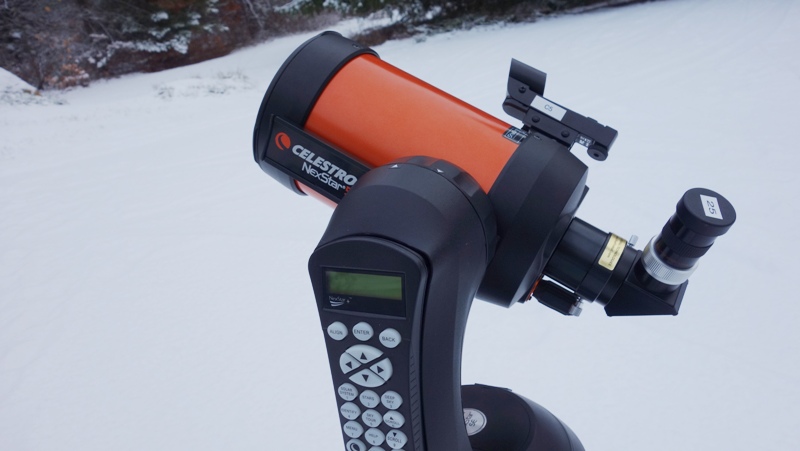
The only thing keeping me from making an unqualified recommendation on any of the NexStars is the mount. This is my third NexStar mount in six years, and my reaction remains mixed, but leaning towards positive. First of all, you need to know that although Celestron labels all these mounts "NexStar" there are actually two models. The mount for the NexStar 4 and the NexStar 5 has a slightly shorter arm than the one for the C6 and the C8. I mention this because I know some of you buy these scopes just to get the mount. Anyone doing this is likely to buy one of the cheaper models, which means you get the shorter version. Be sure you get the one that fits whatever you're planning to put on it. You may think your short refractor will fit, but it may not have enough clearance with the diagonal and eyepiece in place when the scope is pointed at the zenith. Also, these NexStars have a tendency to change over time. The hand controller and the firmware have changed at least once that I know of. The manual only adds to the confusion. Mine still refers to the BACK button as the UNDO button, for example. Also, newer NexStar models have a built in equatorial wedge so you can use it in EQ mode. Since I don't expect to be doing any astrophotography with this mount, I stayed in Alt-Az mode for most of my testing.
The NexStar mount has a couple of mechanical quirks. First, I have a minor issue with the dovetail mounting system. It's difficult to see if the mount is actually engaging the dovetail with the side plates when you tighten the knob. At least once I thought the scope was secure when in fact the side plates were "catching air." I was tightening down on nothing. Because of this I always get a little nervous when attaching the scope to the mount. I'm afraid to let go until I know the mount is actually grabbing the dovetail. Over time, I learned to "press" the OTA against the mount as I tightened the knob; any misalignment tends to manifest itself when I did this. Also, because the whole base moves while slewing, you have to be careful to watch the cord wrap if you use an external battery like I do. I've had the unit pull its cord out. Meade's ETX EC Autostar system is a little better in this regard, as its base stays put while the scope itself turns on top.
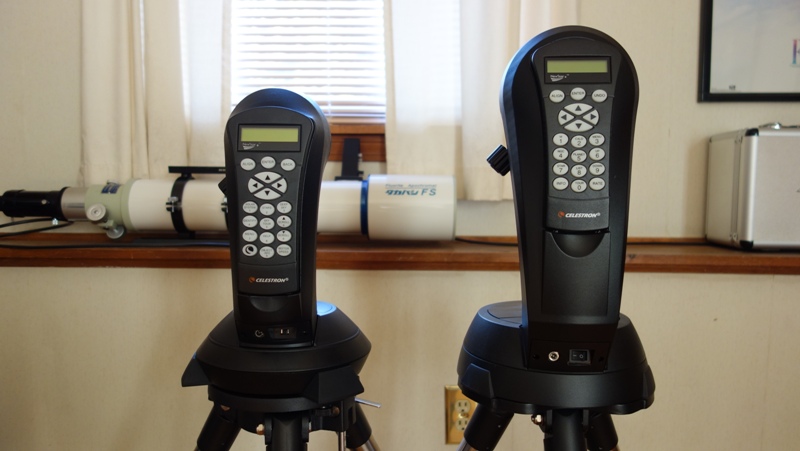
These mounts are both called "NexStar." L is for the 4 and the 5, R is for the 6 and the 8.
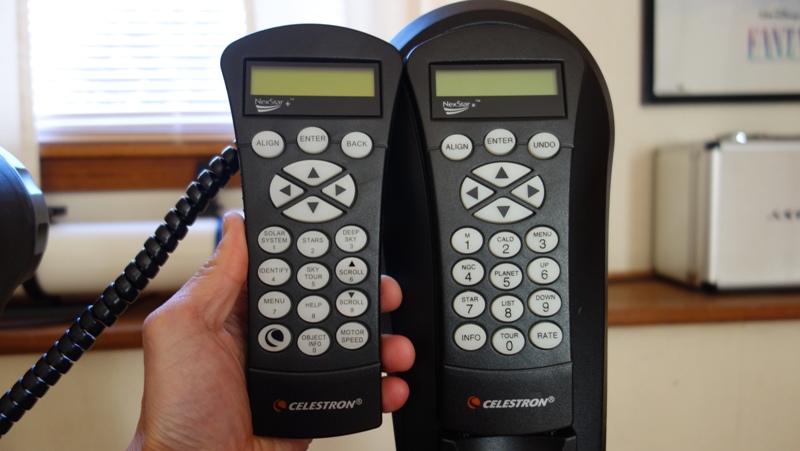
The keypads look the same at first glance, but look closer and the buttons have different labels
In the photos above, the mount on the left is the one that came with my 2016 NexStar 5se, while the one on the right came with the NexStar 8se from a few years ago. On the keypad, I don't have a preference for one layout over the other, but there's always this moment of "Um...which one am I using?" when I start pushing the buttons. Despite having similar operating systems, my two NexStars, CG-5, and AVX have three different keypads among them, and none of them use the same firmware. However, once you learn one system, it isn't a huge stretch to adjust to the others.
I'd rate the accuracy of these NexStar mounts as "good." I have a test that I run on every Goto mount I get. I do a two-star align, then I run the scope across the sky in a 360 degree motion, ending where it began. For example, it's late fall as I write this, and I'll do a two-star align on Deneb and Capella (in that order.) Then I'll make the scope go back to Deneb, to the Double Cluster, to Capella, M31 (I'll use Alpheratz if the moon is out), M15 (ditto for Enif) and then back to Deneb. I'll run the test backwards and forwards over several nights. My CG-5 and AVX mounts pass this test with flying colors. But the NexStar gives us something to talk about. It usually has no trouble finding the alignment stars, no matter how much slewing I do. But this one has trouble putting the Double Cluster in the field of view of a 25 mm eyepiece and it sometimes misses Alpheratz entirely. 25 mm yields only 50X, and the Double Cluster is huge; it shouldn't be that hard. Despite this, it will find the other objects in my "circle" with no problems. The area around the Double Cluster, in particular, proved to be a troublesome object for this NexStar. No matter what kind of alignment method I use, alt-az, equatorial, Sky Align, etc, there's a dead spot in that area of the sky. I also ran the test on my other NexStar mount, which originally held a C8. This older version proved to be a little more accurate, but it also had a dead spot near M15 on the western horizon.
Should this be a concern? Maybe. If you've been around telescopes and mounts for a while, you've seen this before, even with expensive mounts. My concern is for the beginner (a likely purchaser of this telescope) who, having done everything right, finds themselves looking at a blank view in the eyepiece, despite the fact that the hand controller is telling them they're looking at a bright showpiece object. Also keep in mind the C5 has a shorter focal length than the C6 or C8 and as you move up in size, all other things being equal, pointing accuracy will go down. I've often felt the 13 lb, 2000 mm C8 OTA is too much scope for any NexStar mount, and usually recommend buyers get the C6 instead. The careful buyer might keep an eye out for a clean used CG-5. I haven't seen one of the new NexStar Evolution series, but given the number of scopes that cross my path, I expect to run across one at some point (I've had a couple of preliminary reports from club members that sound very encouraging.)
Someone I know refers to a C8 as the Toyota Camry of telescopes. You know what you are getting - a reliable, reasonably-priced piece of equipment that isn't sexy. If this is true, getting a C5 might be like getting a Toyota Corolla. I root for the success of the NexStar series, even with my minor concerns about the mounts. Recommended.
2) Skywatcher 10" Collapsible Dobsonian 2/15/17
(10" f/4.7 Dobsonian reflector, 8X50 right angle finder/bracket, 2" Crayford focuser, 10 mm, 25 mm eyepieces, $699)
I am often asked about this model. It's a good telescope at a reasonable price and I think you'll be happy if you buy one.
The decision as to whether to get one of these usually boils down to two questions. 1) Should I get the Skywatcher Dob, with the collapsible truss design, or should I stick with the simpler and cheaper Orion XT10? 2) Should I get a 10", or will an 8" suffice?
Let's take the second question first. A generation ago, I was getting asked whether an 8" scope was worth the upgrade from a 6". Times have changed. Everyone wants more these days, and that's not necessarily bad. So, is a 10" worth the extra money and bulk vs. an 8"? What I usually tell people is, with very few exceptions, things which are invisible in an 8" scope do not suddenly pop out at you when using a 10". What does happen, however, is that certain things get easier. Take, for example, galaxy M33. The object is a perennial favorite of mine each fall, not the least of which because I spent much of my childhood convinced it had been incorrectly plotted in my star atlases. It looks so big in my star charts, why couldn't I see it? It turns out the galaxy's low surface brightness is spread out over a large area, making it a notoriously difficult object for beginners. I have taught many people how to see M33 over the years, and I usually start by showing it to them in a bigger scope, as opposed to a smaller one. Once you are taught to see it in a big scope, it becomes easier to see it in a small scope (these days, given clear enough skies, I have no problem seeing M33 in a 60 mm refractor.)
So one thing that happens in a bigger scope is that an object's acquisition time is usually reduced. Also, in the aforementioned M33, a 10" will start to show definition in the galaxy's two main spiral arms, which can be a little hard to discern in an 8" (at least from my location.) If you really like looking at galaxies, having a 10" makes you start eagerly anticipating seeing the Virgo Cluster each spring. If you've got a couple of observing seasons under your belt, owning a 10" (as opposed to an 8") makes you start buying bigger star atlases. If you like impressing first time viewers with big, bright views of the Orion Nebula or the moon, a 10" will certainly do the trick.
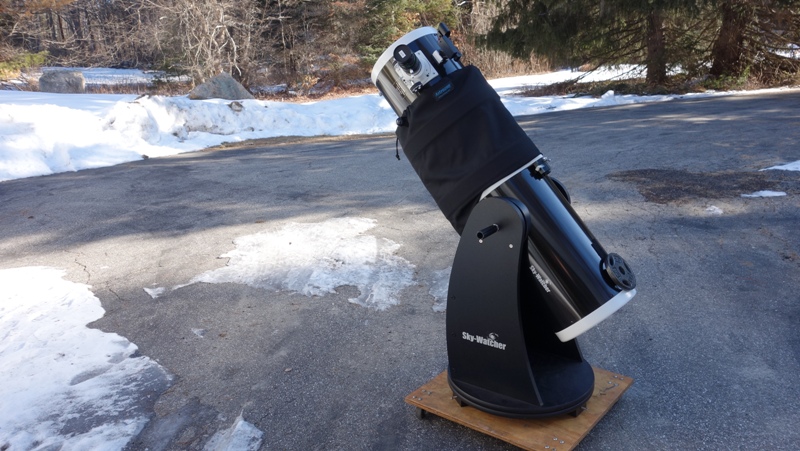
There is a price to be paid for all this, of course. A 10" Dob weighs more than an 8". Although Skywatcher's claimed weight difference on their scopes is only about 10 lbs (~50 lbs for the 8" vs ~60 lbs for the 10") anyone who's moved them around can attest that the subjective difference is much bigger than that 10 lbs would suggest. You should know this review was held up for over a week because I kept putting off taking the scope outside to take these pictures. In other words, the issue has little to do with the scope itself, it has to do with you, and you have to be honest with yourself - how willing are you to lug this thing around when you're tired, or when the skies look like they might not be perfectly clear? Keep in mind you have to bring the scope in at the end of your observing session.
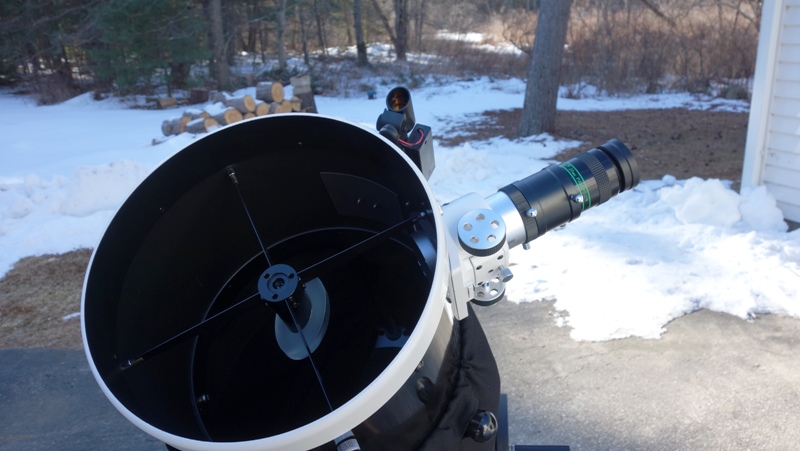
The other question is harder to answer. Is the collapsible truss design an improvement over the traditional solid tube? Many people complain about storing and lugging around a huge steel cylinder. The Skywatcher offers a partial solution, using a three-truss system. You loosen the knobs, pull up until you feel two clicks, tighten them again, and then pull down the shroud. While it's well thought out and well-made (I never once had to recollimate the scope even after extending and retracting the truss numerous times) I wonder what you're actually saving here. People in need of storage space rarely need it in the vertical direction. The tube measures 44" extended, and 32" retracted. While you need only one dust cover for a traditional solid tube Dob, now there are three covers - the usual plastic disc covering the top of the solid part of the tube, a shower cap cover for the upper truss, and the shroud. It seems like a lot, just to get rid of 12" worth of tube. And if you think you're saving weight, think again - adding in all those extra parts results in the Skywatcher having a heavier claimed weight (~60 lbs) vs. an XT10 (~53 lbs.) All of this makes me think the whole collapsible truss mechanism may be the answer to a question no one was asking. But one club member did think of cases where the Skywatcher's design might be an advantage. If you're driving a small car filled with people, the collapsed 32" tube could fit upright in the seat. Also, if you could keep the scope collapsed underneath cabinets, which are generally mounted with their bottom edges around 50" off the floor.
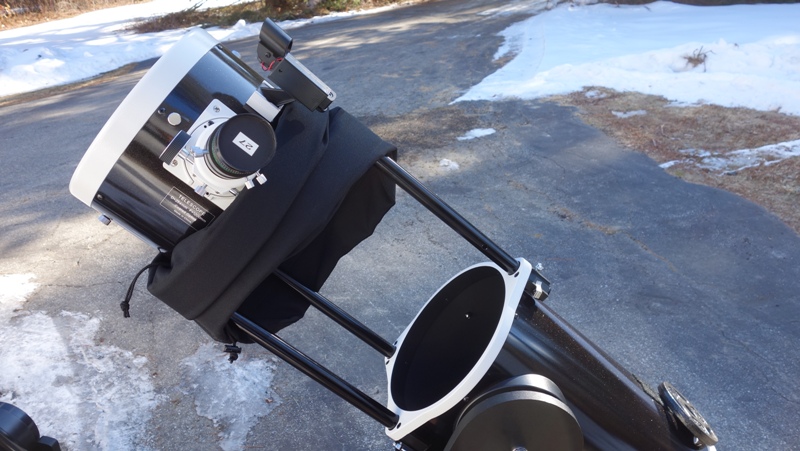
Otherwise, the scope is well made and a pleasure to use. The star test looked very good, with just a trace of undercorrection. It splits Eta Cass cleanly; the wine colored secondary is separated by black space from the primary. NGC 891, which can be difficult in my XT8, is much easier to spot in the 10". The scope starts to show some of the dimmer galaxies in Ursa Major near M81 and M82. Like most inexpensive Dobs, the scope is slightly front heavy. The owner of this one has rigged a counterweight system, which you can see in the photos. While it works, it adds even more weight to the scope. Also like many inexpensive Dobs, the focuser needs a lot of out-focus travel to find focus with many of today's eyepieces (the photo of the upper truss shows the correct focus position of the 27 Panoptic.) I don't like right angle finders, so I substituted a few of my own, eventually settling on a red dot finder. The altitude tension system works well; I think it's smoother than the Orion XT system. The one disadvantage is the handles stick out, just waiting to grab your loose clothing in the dark.
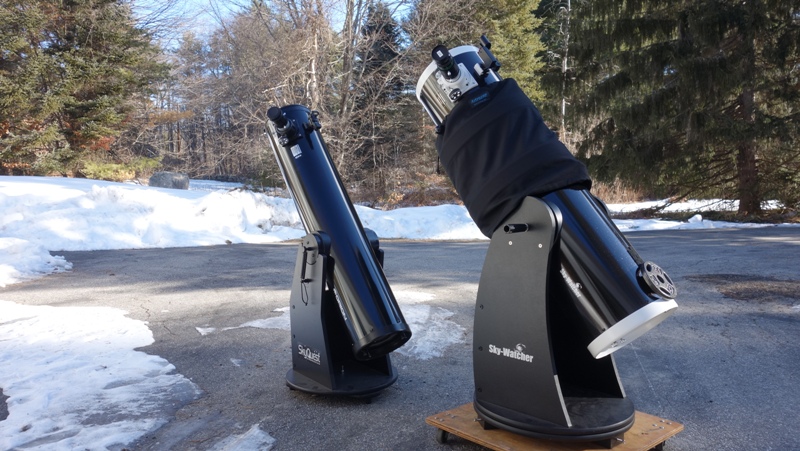
10" Skywatcher next to an Orion XT8
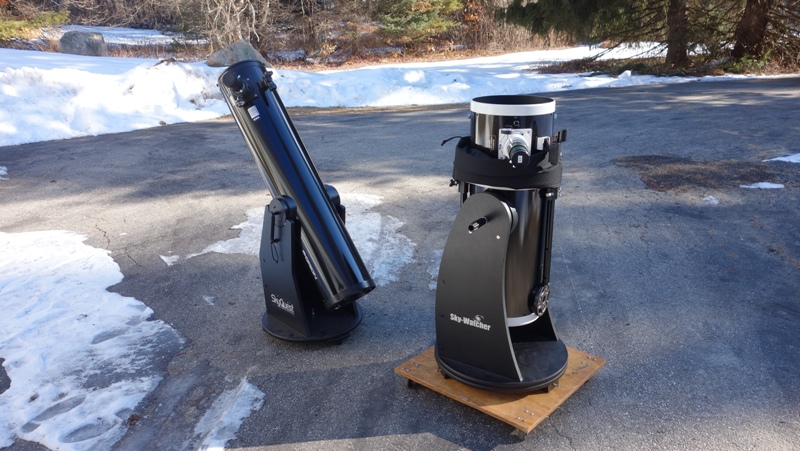
I posed a question to some club members. If you could have only one, which would you get - the Orion XT10 or the Skywatcher? Mike and Dan have owned both, while John R and I have owned one, but not the other. Keep in mind this is not a scientific survey, nor am I telling you what to buy. But the results were interesting.
Dan: I'd take the XT10.
John R: XT10.
Mike: The Skywatcher allows me to put the scope in my car, plus it's easier to get the thing out the door. Skywatcher.
Me: The XT10 is lighter, simpler, and cheaper. Taken by themselves, none of those factors is a big deal breaker. But add them up, and they start to mean something. XT10.
I should note that among us, Mike has the smallest house, the smallest car, and is the only one of us who does not have a garage. It's not surprising he placed value on the Skywatcher's space saving design. Of the factors I mentioned, the garage is the big one. While I had the scope, I left the whole thing assembled in the garage on a wheeled dolly; setup was as simple as kicking the dolly into the driveway. So it's your call. 8" or 10", XT or Skywatcher. I don't think you'd go wrong with any of the choices.